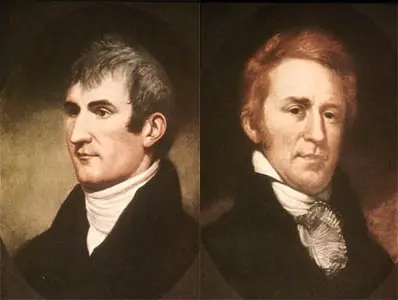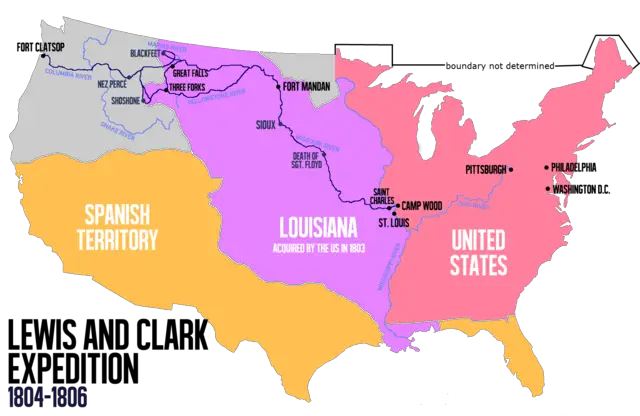Lewis and Clark Expedition
The Lewis and Clark Expedition is considered to be one of the most important exploration events in U.S. history. President Thomas Jefferson knew the importance of exploring the new land area that had just been bought from the French in the Louisiana Purchase.
Jefferson selected Meriwether Lewis to lead the expedition, and Lewis wanted William Clark to help him lead. The amount of land in the Louisiana Purchase almost doubled the size of the United States, and the expedition would take over two years.

Exploring the new land involved a lot of dangers, including horrible weather, rough terrain, treacherous waters, disease, near starvation, and both hostile and friendly Native Indians. The team traveled over 8,000 miles, mapping out the geography, keeping journals of animals, plants, and other ecological information, as well as including everything that they could about this new North American uncharted area.
- President Jefferson had a former relationship with Meriwether Lewis when he was his 27-year-old personal secretary. Jefferson knew of Lewis’ history as part of the Virginia state militia that assisted in putting down the Whiskey Rebellion as well as his role as U.S. Army Captain. Jefferson had a calm confidence in Lewis’ abilities, education, and knowledge to do the job on this expedition.
- William Clark had served with Lewis in the regular Army after he had joined the state militia in Kentucky. Clark held a commission as lieutenant of infantry under President George Washington. Due to serving together, Lewis knew well that Clark was dependable and would make an excellent co-leader.
- The importance of the Louisiana Purchase meant that the size of the United States had almost doubled. Little was known about the far west areas, as ownership had changed hands a few times. France had originally claimed ownership, but after the French and Indian War turned over some of Louisiana to Spain and the rest to Great Britain. In 1799 Napoleon Bonaparte became the leader of France, and he wanted the old territory back. He knew the benefits of trade along the Mississippi River and the value of the port at New Orleans.
- King Charles IV of Spain gave the Louisiana Territory back to France in 1802, but he also revoked America’s port access. This nearly caused a war until President Jefferson, and James Monroe got Bonaparte to sell the 827,000 square miles known as the Louisiana Territory for $15 million. What few know is that Bonaparte actually sold the Port of New Orleans for $10 million and threw the rest of the land in for an additional $5 million.

- Jefferson worked with Congress to finance an expedition to survey the lands and gather as much information as possible. He knew that the population of the United States was growing and it needed places for expansion and successful farming.
- Preparing for such a vast expedition was almost daunting. Lewis had studied botany, zoology, medicine, and astronomy, and he used his skills to look through as many of the existing maps as possible. Both Lewis and Clark led the expedition equally, and they each had particular skills to offer as the trip was planned.
- The trip was going to cover areas starting at the Mississippi River, then west to the Rocky Mountains, then from the southern area of the Gulf of Mexico to the northern Canadian border. They wouldn’t include what is now Texas and part of California because Spain still owned that land area.
- President Jefferson called the expedition the “Voyage of Discovery,” and referred to the members of the expedition as the “Corps (KOR) of Discovery.” Jefferson knew that this would be one of the most challenging expeditions that had ever happened in the United States, and after Congress approved the funding, Lewis and Clark and their team members set out to explore the newest areas of the U.S.



